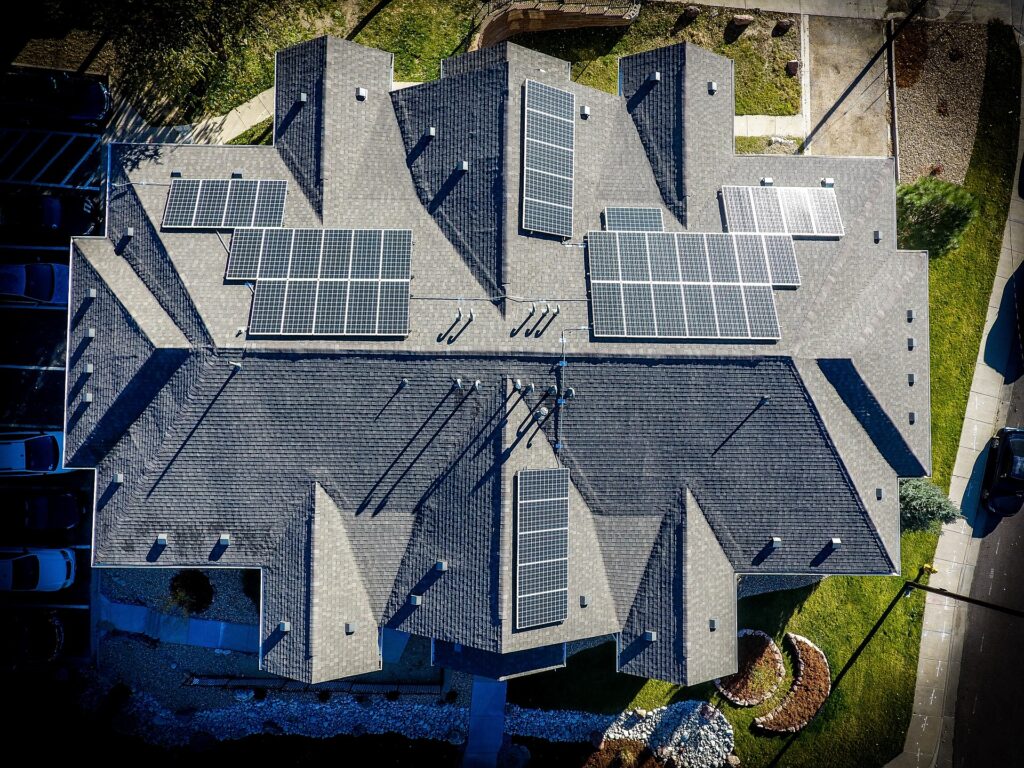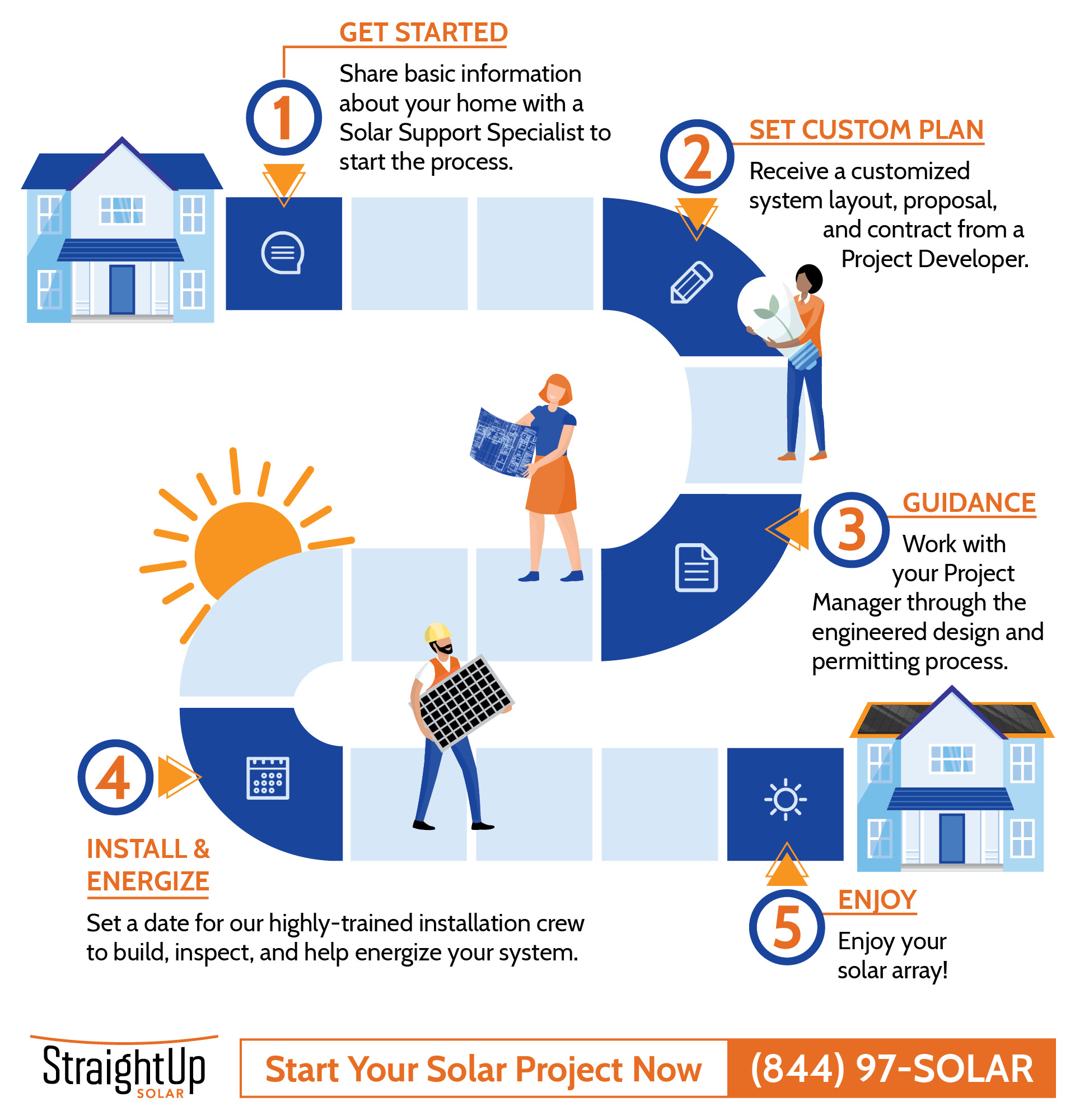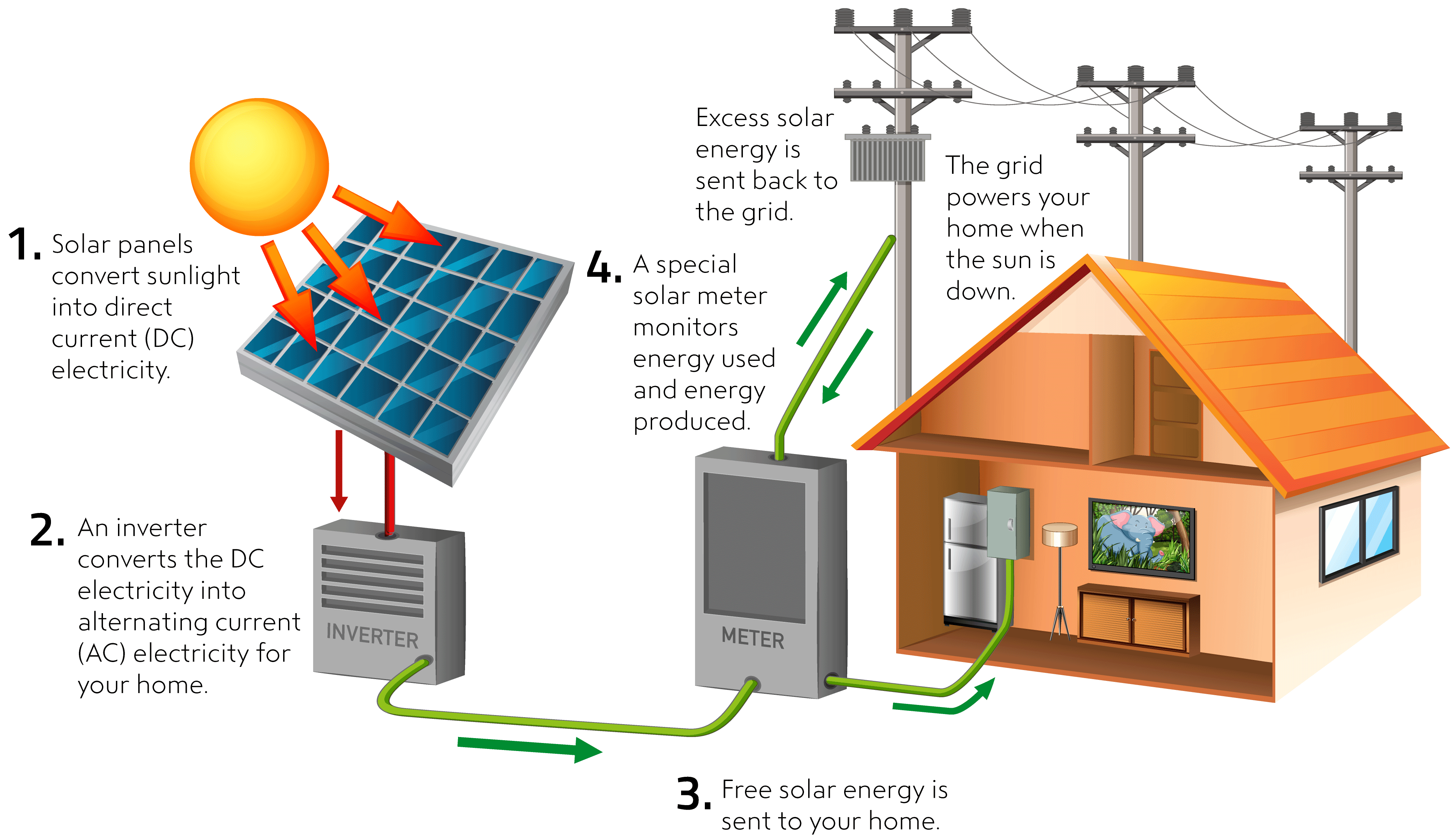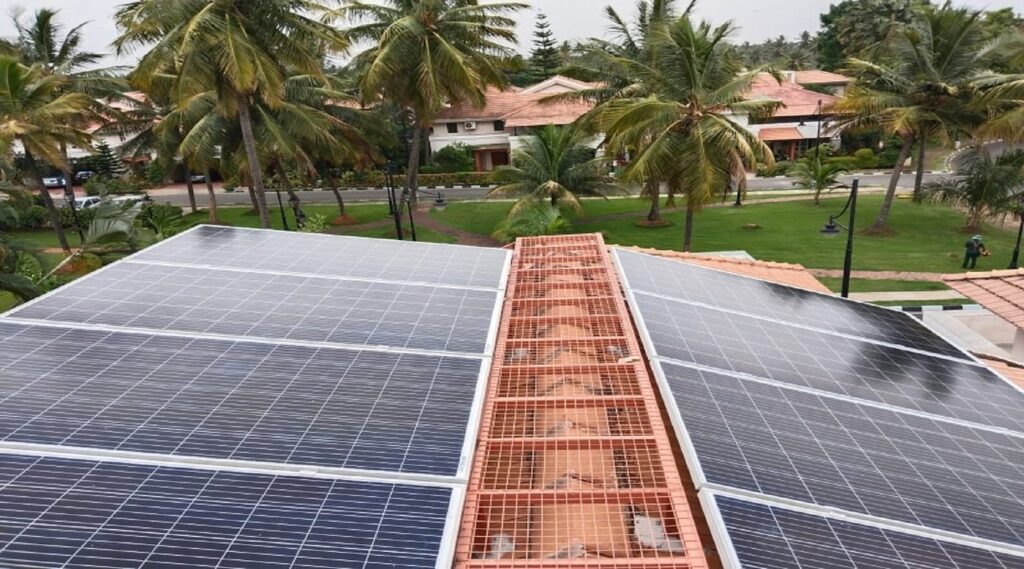Installing Solar Panel Process Step by Step process that includes site assessment, obtaining permits, installing the mounting system, connecting panels, and securing electrical wiring. This article will guide you through each stage, giving you a clear understanding of the solar panel installation process and its components.

Installing a solar panel system involves several key steps to ensure it functions efficiently and safely. Here’s a step-by-step guide to the process:
1. Assessment and Planning
- Site Assessment: A professional will evaluate your location to determine if it’s suitable for solar power. This involves checking roof condition, orientation, shading, and available space.
- Energy Needs Analysis: Calculate your household or business energy consumption to determine the size of the system required.
- System Design: Based on the assessment, a solar system design is created, specifying the type, number of panels, and their placement.
2. Permitting and Paperwork
- Obtain Permits: Apply for the necessary building permits from local authorities. This may include electrical permits and zoning approvals.
- Apply for Incentives: If applicable, apply for government incentives or rebates for solar installation.
3. Procurement of Materials
- Order Equipment: Purchase the solar panels, inverters, mounting systems, and other required components.
- Delivery: Ensure all equipment is delivered to the site.
4. Mounting System Installation
- Roof Preparation: If roof-mounted, ensure the roof is structurally sound to support the system.
- Install Mounting: Attach the mounting system to the roof or ground, ensuring it’s aligned and secured to hold the panels.
5. Solar Panel Installation
- Attach Panels: Secure the solar panels to the mounting system. Proper alignment and angle are crucial for maximizing sunlight exposure.
- Connect Wiring: Connect the solar panels to the inverter using the appropriate wiring. This step must be done carefully to ensure safety and efficiency.
6. Electrical Connection
- Install Inverter: Mount and connect the inverter, which converts the DC electricity generated by the panels into AC electricity used in your home.
- Set Up Electrical Panel: Connect the inverter to the electrical panel, allowing solar energy to power your home.
- Install a Meter: In some cases, a bi-directional meter is installed to track the energy produced and sent back to the grid (net metering).
7. System Testing
- Inspect and Test: A thorough inspection is done to ensure all components are properly installed. The system is then tested to ensure it’s operating correctly.
- Grid Connection: If grid-tied, the system will be connected to the local electricity grid. This may require approval from the utility company.
8. Monitoring Setup
- Install Monitoring System: Set up a monitoring system to track the performance of the solar panels, which can often be done remotely via an app or online portal.
9. Inspection and Approval
- Final Inspection: A local government inspector may need to verify that the installation meets all codes and regulations.
- System Activation: Once approved, the system can be activated and start generating electricity.
10. Maintenance
- Regular Maintenance: Perform routine checks and cleaning to ensure the system operates at peak efficiency. This may involve cleaning the panels and inspecting the inverter and connections.
Solar energy has become an increasingly popular and viable alternative to traditional sources of electricity. With the potential to save money on utility bills and reduce your carbon footprint, many homeowners and businesses are considering installing solar panels. However, the installation process can be complex, involving several steps to ensure a successful and safe installation.
This article will provide a detailed guide, outlining each stage of the solar panel process, allowing you to make an informed decision and have a clearer understanding of what to expect during installation.

Credit: straightupsolar.com Get
Choosing The Right Solar Panel
When it comes to choosing the right solar panel for your home, it’s essential to consider various factors that will affect its performance and suitability for your specific needs. From researching the types of solar panels available to evaluating your energy requirements and available roof space, each step plays a crucial role in ensuring you make an informed decision that aligns with your goals for renewable energy integration.
Researching Types Of Solar Panels
- Monocrystalline
- Poly-Crystalline
- Thin-Film
Researching the different types of solar panels available in the market is crucial to understanding their efficiency, durability, and cost-effectiveness. Monocrystalline panels are known for their high efficiency and sleek appearance, while poly-crystalline panels are more budget-friendly without significantly compromising performance. On the other hand, thin-film panels are lightweight and flexible, making them suitable for specific installation requirements.
Considering Energy Needs And Roof Space
Before making a decision, carefully assess your energy needs and available roof space to determine how many solar panels you need and what size will fit. Calculating your average energy consumption and examining your roof’s orientation and shading will help in determining the optimal panel configuration for maximum energy production.

Credit: www.sunvalleysolar.com
Installation And Set-up
Once you have gone through the initial steps of assessing your roof’s suitability, acquiring the necessary permits and approvals, and determining the optimal placement for your solar panels, it’s time to move forward with the installation and set-up process. This pivotal stage involves bringing your solar panel system to life, converting sunlight into usable electricity. In this article, we will guide you through the step-by-step installation process, ensuring a seamless and successful transition to solar power.
Assessing Roof Suitability
Before proceeding with the installation and set-up of your solar panels, it is crucial to assess the suitability of your roof. This involves evaluating its orientation, tilt, shading, and overall structural integrity. Here is what you need to consider:
Orientation: Ensure your roof has sufficient south-facing exposure, as this will optimize sunlight absorption. The more direct sunlight your panels receive, the more electricity they will produce.
Tilt: While a south-facing orientation is ideal, minor deviations up to 30 degrees east or west will not significantly impact efficiency. However, it is important to note that a lower tilt angle during winter months may result in decreased electricity production.
Shading: Shadows cast by nearby trees, chimneys, or buildings can limit the efficiency of your solar panels, so it is essential to minimize or eliminate shading. Trim any overhanging branches or consider alternative panel placement to maximize sunlight exposure.
Structural Integrity: Before installation, ensure your roof is in good condition and capable of supporting the weight of the solar panel system. It is advisable to consult a professional to assess roof load capacity and make any necessary reinforcements.
Acquiring Permits And Approvals
Obtaining the required permits and approvals is a critical step in the solar panel installation process. Local regulations and building codes vary, so it is essential to familiarize yourself with the specific requirements of your area. Here is what you need to keep in mind:
Research: Investigate the necessary permits, forms, and documentation required by your local authorities. This typically includes obtaining electrical and building permits, submitting system plans, and seeking approval from homeowner associations, if applicable.
Professional Assistance: While you can undertake this process yourself, seeking professional guidance from experienced solar installers who are well-versed in local regulations can streamline the process and ensure compliance with all necessary building codes.
Patience: Permitting processes can vary in duration, so it is important to be patient. Factor in the time required to secure these permits when planning your solar panel installation timeline.
Determining Optimal Panel Placement
The optimal panel placement is crucial to maximize the efficiency and productivity of your solar panel system. Consider the following factors when determining where to install your panels:
Direct Sunlight: As mentioned earlier, solar panels generate electricity from sunlight. Therefore, ensure your panels are positioned to receive maximum sunlight exposure throughout the day. Avoid shadowing from nearby obstacles, such as trees or neighboring buildings.
Roof Space: Evaluate the available roof space to determine how many panels you can install. Calculate the energy requirements of your household to estimate the number of panels needed for optimal energy production.
Roof Slope: While a flat roof is suitable for solar panel installation, a slight slope can facilitate self-cleaning, promoting efficient operation. Consider the potential benefits of a sloped roof when planning panel placement.
Wiring and Connections: Ensure proper wiring and connections between the panels, inverters, and electrical systems. Professional solar installers are skilled in setting up the wiring to ensure optimal performance and safety.
Monitor and Maintain: After panel installation, regularly monitor their performance, efficiency, and cleanliness to ensure long-term productivity. Schedule periodic inspections and cleanings to remove any dirt or debris that may hinder performance.
Mounting The Solar Panels
When it comes to installing solar panels, one of the critical steps is properly mounting them on the roof. Mounting the solar panels securely is essential to ensure their optimal performance and longevity. In this blog post, we will guide you through the step-by-step process of mounting solar panels on your roof, so you can harness the power of the sun and start saving on your energy bills.
Preparing The Roof Surface
Before you start installing the solar panels, it is crucial to prepare the roof surface to ensure a sturdy and long-lasting installation. Here are the steps involved:
- Inspect the roof: Begin by examining the roof surface to identify any potential issues that need to be addressed. Look for any damages, leaks, or weak areas that might affect the solar panel installation.
- Clean the roof: Make sure the roof surface is clean and free from any debris or dirt. Remove any obstacles that may hinder the installation process.
- Check the roof integrity: Ensure that the roof structure is strong enough to support the weight of the solar panels. Engage a professional if you are unsure about the structural integrity of your roof.
Attaching The Mounting Hardware
Once the roof surface is properly prepared, the next step is to attach the mounting hardware. This hardware serves as the foundation for securing the solar panels to the roof. Here’s what you need to do:
- Identify the optimal location: Determine the best location to install the mounting hardware, considering factors like accessibility, sun exposure, and structural integrity.
- Place the mounts: Position the mounting brackets or rails on the roof, ensuring they are level and accurately aligned. Use a chalk line or laser level to ensure precision.
- Secure the mounts: Attach the mounts to the roof surface using appropriate roofing screws, ensuring they are tightly fastened. Make sure to follow manufacturer guidelines and local building codes.
Securing The Panels
Now that the mounting hardware is securely in place, it’s time to secure the solar panels. Properly securing the panels ensures their stability and prevents any damage from external elements. Follow these steps:
- Position the panels: Carefully place the solar panels onto the mounting hardware, ensuring they are correctly aligned and oriented towards the sun. Double-check that all connections are properly aligned.
- Attach the panels: Secure the panels to the mounting hardware using the provided clamps or brackets. Make sure to tighten the clamps enough to hold the panels firmly in place, but not too tight to risk damaging them.
- Verify the connections: Once the panels are securely attached, check all electrical connections to ensure they are properly connected and tightened. This step is crucial to guarantee the efficient functionality of your solar panel system.
Wiring And Connectors
When it comes to the solar panel installation process, the wiring and connectors play a crucial role in ensuring the system functions efficiently. Installing the racking system, connecting the panels in series or parallel, and adding grounding and disconnecting devices are essential steps in this phase. Let’s delve into each of these steps in more detail.
Installing The Racking System
Before wiring the solar panels, it’s crucial to install the racking system securely. This framework provides the foundation for mounting the panels on the roof or the ground. Ensure that the racking system is placed in a way that maximizes sunlight exposure throughout the day, optimizing the panel efficiency.
Connecting The Panels In Series Or Parallel
After securing the racking system, the next step involves connecting the solar panels. This process can be achieved by wiring the panels in series or parallel configurations. When connecting in series, the positive terminal of one panel is linked to the negative terminal of the next, increasing the voltage. On the other hand, parallel connections involve linking all the positive terminals together and connecting all the negative terminals together, resulting in a higher current output. Carefully analyzing the electrical requirements helps determine the appropriate configuration.
Adding Grounding And Disconnecting Devices
Lastly, incorporating grounding and disconnecting devices is essential to ensure the safety and proper functioning of the system. Grounding devices protect against electrical faults and ensure the system’s stability during adverse conditions. Additionally, disconnecting devices allow for safe maintenance and shutdown procedures when needed, safeguarding both the system and the individuals working on it.
Inverter And Battery Installation
In order to harness the energy generated by solar panels, it’s vital to have a reliable inverter and battery system. The inverter converts the direct current (DC) produced by the panels into usable alternating current (AC) electricity while the battery stores excess energy for later use. In this section, we will discuss the key steps involved in selecting the right inverter type, installing the inverter, and connecting the battery.
Selecting The Right Inverter Type
Choosing the appropriate inverter type is crucial for optimal performance of your solar panel system. There are mainly three types of inverters to consider:
- String Inverters: These are the most commonly used inverters in residential solar installations. They are efficient and cost-effective, but their performance can be affected by shading or malfunctioning panels.
- Micro-Inverters: Unlike string inverters, micro-inverters are installed on each individual panel. This allows them to optimize the power output of each panel independently, making them the ideal choice for systems with shading issues or complex roof designs.
- Power Optimizers: These devices perform a similar function to micro-inverters by maximizing the output of each panel. However, they work in conjunction with a central inverter, combining the benefits of both string inverters and micro-inverters.
Installing The Inverter
Proper installation of the inverter ensures efficient energy conversion and maximizes the performance of your solar panel system. Here’s a step-by-step guide to installing the inverter:
- Choose a Suitable Location: Select a well-ventilated area close to your electrical panel and away from direct sunlight or extreme temperatures.
- Mount the Inverter: Securely attach the inverter using the provided mounting brackets or screws. Ensure that it is level and properly grounded to prevent any electrical hazards.
- Connect DC and AC Wires: Follow the manufacturer’s instructions to connect the DC wires from the panels to the DC terminals on the inverter. Then, connect the AC output wires from the inverter to your electrical panel.
- Perform Safety Checks: Before turning on the inverter, double-check all connections and ensure that there are no loose wires. Verify that the inverter is properly connected to the electrical system and that all safety measures are in place.
Connecting The Battery
Incorporating a battery into your solar panel system allows you to store excess electricity for use during periods of low solar energy production. Here are the steps to connect the battery:
- Select the Right Battery: Determine your energy storage requirements and choose a battery that matches your needs in terms of capacity, voltage, and lifespan.
- Clean and Inspect the Battery: Ensure that the battery terminals are clean and free from any corrosion. Verify that the battery is in good condition and meets the manufacturer’s specifications.
- Connect the Battery: Follow the provided instructions to connect the battery to the designated terminals on the inverter. Pay attention to proper polarity and tighten the connections securely.
- Test the Battery Backup: Turn on the system and test the battery backup functionality. Verify that the battery is charging and discharging correctly, and monitor its performance over time.
Final Testing And Inspections
Once the solar panel installation is complete, the final step in the process is to conduct thorough testing and inspections. This crucial stage ensures that the solar system is performing optimally and meets all safety and code standards. During this phase, two key areas are assessed: testing the solar system’s performance and conducting safety and code inspections.
Testing The Solar System’s Performance
Testing the performance of the solar system is essential to guarantee that it is generating the expected amount of electricity. This step involves analyzing the energy output and verifying if it aligns with the projected performance. An experienced technician will carefully examine the results to ensure the solar panels are functioning at their peak efficiency. They will measure the system’s output under various conditions, including different angles of sunlight and weather patterns, to assess its performance reliability.
To accurately test the solar system’s performance, advanced monitoring tools and equipment are employed. These devices track the amount of energy generated and provide real-time data on its efficiency. By closely monitoring the system’s performance, any inefficiencies or malfunctions can be identified promptly and addressed to maintain optimal energy production.
Conducting Safety And Code Inspections
Alongside testing the system’s performance, safety and code inspections are carried out to ensure compliance with local regulations and protect both the homeowner and the community. These inspections encompass a comprehensive evaluation of the solar installation to verify that all electrical connections, wirings, and system components meet the required safety standards.
During safety inspections, inspectors will assess potential hazards such as electrical faults, improper grounding, or fire risks. They also verify that all wiring is appropriately installed and shielded to prevent any accidents or electrical failures. In addition, safety inspections ensure that the solar panels are safely interconnected with the electrical grid, meeting the necessary protocols to protect against power surges.
Code inspections, on the other hand, ensure that the solar installation complies with local building codes and regulations. These inspections cover aspects such as the system’s design, structural integrity, and the correct installation of required equipment, such as inverters and meters. By adhering to these codes, the installation is deemed safe, reliable, and effective, minimizing any potential risks to the property or individuals.
In conclusion, the final testing and inspections stage is a crucial part of the solar panel installation process. By carefully testing the solar system’s performance and conducting thorough safety and code inspections, homeowners can have peace of mind knowing that their solar installation is operating efficiently and meets all necessary regulations. This ensures a reliable and sustainable source of energy for years to come.
Maintenance And Monitoring
Maintenance and monitoring are crucial aspects of ensuring that your solar panels continue to operate efficiently and deliver maximum energy production. Regular maintenance and monitoring not only extend the lifespan of the solar panels but also help in identifying any issues that may affect their performance.
Cleaning The Solar Panels
Regular cleaning of solar panels is essential to ensure their optimal performance. Dust, dirt, and other debris can accumulate on the panels, reducing their efficiency. Use a soft brush or a sponge with soapy water to gently clean the surface of the panels. Avoid using abrasive materials or harsh chemicals as they can damage the panels. Additionally, consider scheduling professional cleaning services for a thorough maintenance routine.
Checking And Replacing Parts
Periodically inspect all the components of the solar panel system, including the mounting hardware, wiring, and inverters. Look for signs of wear and tear, corrosion, or any physical damage. Ensure that all the connections are secure and tighten any loose fittings. Replace any damaged or malfunctioning parts promptly to prevent further issues and maintain the system’s efficiency.
Monitoring Energy Production
Regularly monitor the energy production of the solar panels to ensure that they are generating the expected output. Utilize monitoring software or tools provided by the system manufacturer to track the performance of the panels. Look for any significant drops in energy production, which could indicate a problem with the system that requires attention. Additionally, keep an eye on the weather conditions as they can also impact the solar panel’s efficiency.

Credit: ae-solar.com
Frequently Asked Questions On Solar Panel Process Step By Step
How Are Solar Panels Manufactured?
Solar panels are manufactured through a process that involves assembling photovoltaic cells, adding protective layers, and framing the panels for installation.
How Do Solar Panels Convert Sunlight Into Electricity?
Solar panels convert sunlight into electricity through the photovoltaic effect. When sunlight hits the panels, the photovoltaic cells absorb the energy and generate DC electricity.
How Long Do Solar Panels Last?
Solar panels are designed to have a lifespan of around 25 to 30 years, but with proper maintenance, they can often continue producing electricity for even longer.
Conclusion
In this comprehensive guide, we covered the step-by-step process of solar panel installation. From initial assessment to final connection, each stage is vital to ensuring a successful and efficient solar system. By understanding the process, consumers can make informed decisions and harness the benefits of renewable energy for their homes or businesses.